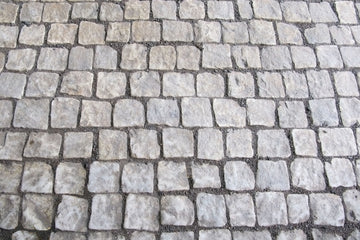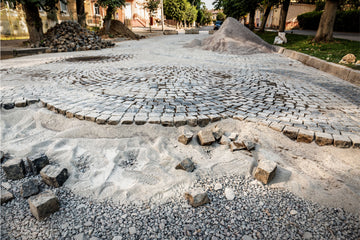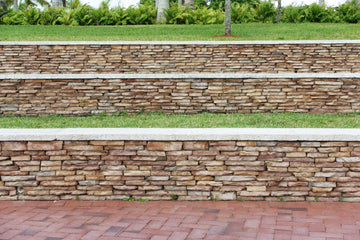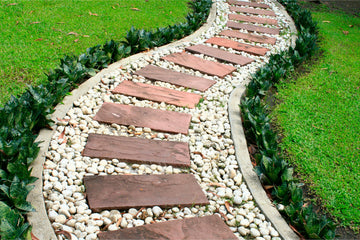Paving Stone Thickness Guide: When to Use 20mm, 30mm, or 40mm

Selecting appropriate natural stone thickness represents a critical decision in landscape design and construction projects. For landscape contractors, garden designers, and stone suppliers, understanding when to specify 20mm, 30mm, or 40mm paving stone ensures structural integrity, cost efficiency, and long-term project success. This comprehensive guide examines the technical and practical considerations for natural stone thickness selection across various applications.
Understanding Natural Stone Thickness Standards
Natural stone paving is commonly available in calibrated thicknesses of 20mm, 22mm, 25mm, 30mm, and 40mm, with some manufacturers offering custom thickness options for specific projects. Calibrated stone undergoes machine processing to achieve consistent thickness, facilitating easier installation and more predictable structural performance. Hand-cut natural stone may show thickness variation of 3-5mm, requiring additional installation expertise and mortar bed adjustments.
Stone thickness directly impacts load-bearing capacity, installation methodology, substrate requirements, and overall project costs. Thicker natural stone paving generally provides greater structural strength but increases material costs, shipping weight, and installation complexity. Understanding the relationship between thickness and application ensures optimal specification for each landscape project.
20mm Natural Stone Paving: Applications and Limitations
Ideal Applications for 20mm Stone
Twenty-millimeter natural stone paving suits light-duty pedestrian applications where vehicle traffic is prohibited. Residential garden pathways, patio areas, pool surrounds, and decorative landscape features perform well with 20mm sandstone, limestone, or granite paving when properly installed on suitable substrates.
Commercial applications for 20mm stone include rooftop terraces, balcony installations, and raised pedestal systems where weight considerations limit thicker material use. Indoor-outdoor transition areas in residential properties benefit from 20mm stone, creating seamless visual flow while maintaining appropriate structural performance for foot traffic.
Installation Requirements for Thin Natural Stone
Installing 20mm natural stone paving requires fully supported substrate conditions with minimal deflection. A concrete base with mortar bed installation provides optimal support, distributing loads evenly across the thinner stone surface. Sand-bedded installations with 20mm stone demand exceptional sub-base preparation, proper compaction, and may show reduced longevity compared to thicker alternatives.
Edge support becomes particularly critical with 20mm paving stone to prevent chipping and breakage at vulnerable perimeter areas. Landscape installers should specify edge restraints and consider slightly thicker stone for border courses where mechanical damage risk increases.
Cost Considerations
Twenty-millimeter natural stone offers significant cost advantages in material pricing and shipping expenses. Lower weight reduces freight costs for international stone imports, making 20mm options attractive for price-sensitive projects. However, potential replacement costs due to breakage in unsuitable applications may eliminate initial savings, making thickness selection a critical value decision rather than simple cost reduction.
30mm Natural Stone Paving: The Versatile Standard
Why 30mm Represents Industry Standard
Thirty-millimeter natural stone paving strikes an optimal balance between structural performance, installation versatility, and cost efficiency. This thickness accommodates diverse installation methods including mortar bed, sand bed, and gravel applications while providing sufficient strength for most residential and commercial landscape projects.
Garden designers and landscape architects frequently specify 30mm sandstone paving, limestone flags, or granite pavers as the default choice for general paving applications. This thickness performs reliably across variable soil conditions, seasonal ground movement, and typical pedestrian traffic patterns found in residential gardens, commercial courtyards, and public pathway installations.
Application Range for 30mm Stone
Residential driveways with occasional vehicle traffic suit 30mm natural stone when installed on properly engineered sub-bases with adequate compaction and drainage provisions. Garden patios, entertainment areas, and outdoor dining spaces benefit from 30mm stone's durability while maintaining reasonable project costs.
Commercial landscaping projects including hotel courtyards, restaurant terraces, retail plaza walkways, and office park pathways typically specify 30mm natural stone for reliable long-term performance. This thickness withstands regular pedestrian traffic, outdoor furniture loads, and maintenance equipment without excessive breakage or surface degradation.
Installation Flexibility
Thirty-millimeter natural stone accommodates various installation techniques, providing flexibility for contractors working across different project conditions. Sand-bedded installations work effectively with 30mm stone over well-prepared, compacted sub-bases. Mortar bed applications provide maximum stability for high-value installations, while gravel bed systems offer permeability benefits for sustainable landscape designs.
The additional thickness compared to 20mm stone reduces breakage risk during handling and installation, potentially lowering overall project costs despite higher material pricing. Experienced installers report fewer replacements and faster installation progress with 30mm versus thinner alternatives.
40mm Natural Stone Paving: Heavy-Duty Applications
When to Specify 40mm Stone Thickness
Forty-millimeter natural stone paving provides maximum structural performance for vehicular applications and heavy commercial use. Residential driveways with regular vehicle traffic, commercial parking areas, and loading zones require 40mm stone to prevent cracking and surface degradation under repeated wheel loads.
Public plaza installations with heavy pedestrian traffic, commercial building entrances, and transportation facility hardscaping benefit from 40mm natural stone's enhanced durability. Municipal landscape projects, urban streetscape improvements, and heritage restoration work often mandate minimum 40mm thickness for longevity expectations exceeding 25-30 years.
Structural Performance Advantages
The increased mass of 40mm natural stone provides superior load distribution, reducing point-load stress that causes thinner stone to crack. Vehicle turning movements, impact loads from dropped objects, and concentrated furniture loads present minimal risk to properly installed 40mm paving compared to thinner alternatives.
Sandstone paving at 40mm thickness demonstrates significantly improved flexural strength, while granite and limestone at this thickness can support light vehicular traffic even on sand-bedded installations when sub-base construction follows engineering specifications.
Installation and Cost Implications
Forty-millimeter natural stone increases project costs through higher material pricing, increased shipping weight, and more demanding installation requirements. Manual handling becomes more challenging, potentially requiring mechanical lifting equipment for large-format pavers. Substrate preparation must accommodate the additional stone weight, sometimes necessitating enhanced sub-base thickness and compaction.
Despite higher upfront costs, 40mm natural stone frequently provides superior lifecycle value for appropriate applications. Reduced replacement frequency, lower maintenance requirements, and extended service life justify the premium investment for vehicular applications and high-traffic commercial installations.
Special Considerations for Stone Type
Sandstone Thickness Selection
Indian sandstone paving demonstrates variable density based on quarry origin, affecting thickness requirements. Higher-density sandstone may perform adequately at thinner dimensions, while more porous varieties benefit from increased thickness. Landscape contractors should consult stone suppliers regarding specific product density when finalizing thickness specifications.
Limestone Paving Thickness
Limestone's relatively consistent density simplifies thickness selection compared to sandstone. However, limestone's susceptibility to acid weathering in certain climates may favor thicker options for enhanced longevity. Coastal installations and areas with acidic soil conditions benefit from 30-40mm limestone rather than minimum thickness specifications.
Granite Thickness Requirements
Granite's exceptional strength allows reduced thickness for equivalent performance compared to sandstone or limestone. However, standard thickness options remain preferable for installation efficiency and aesthetic consistency with adjacent materials.
Technical Specifications for Project Success
Sub-base Requirements by Thickness
Twenty-millimeter stone requires rigid support with minimal deflection, typically necessitating concrete bases for vehicular-free applications. Thirty-millimeter stone performs adequately on compacted aggregate sub-bases of 100-150mm depth for pedestrian use, increasing to 200-300mm for occasional vehicle traffic. Forty-millimeter stone installation follows engineering specifications for vehicular pavement design, with sub-base depth determined by traffic loads and soil bearing capacity.
Joint Width and Thickness Relationship
Thicker natural stone tolerates wider joint spacing without compromising structural performance. Twenty-millimeter stone benefits from tighter joints (3-5mm) for load distribution, while 30-40mm stone accommodates 5-10mm joints in most applications. Joint material selection should complement thickness choice, with resin-based jointing providing maximum strength for thinner stone installations.
The Final Say
Selecting appropriate natural stone thickness between 20mm, 30mm, and 40mm options directly impacts project performance, longevity, and value. Landscape designers, contractors, and stone suppliers must evaluate application requirements, traffic loads, installation methodology, and budget constraints when specifying paving thickness.
Twenty-millimeter stone serves light-duty pedestrian applications with cost efficiency, 30mm provides versatile performance across diverse landscape uses, and 40mm delivers maximum durability for vehicular and heavy commercial installations. By matching thickness to application demands, professionals ensure optimal outcomes for natural stone paving projects worldwide.






